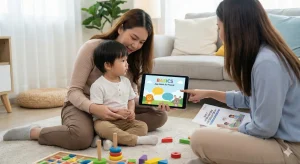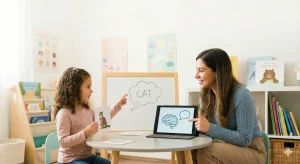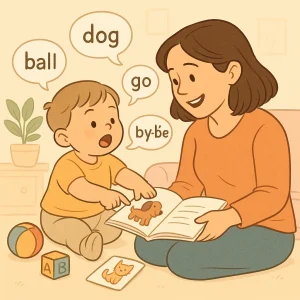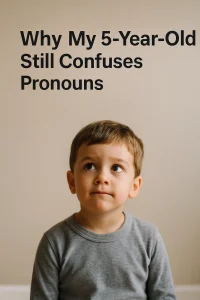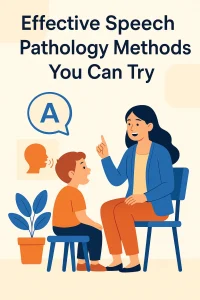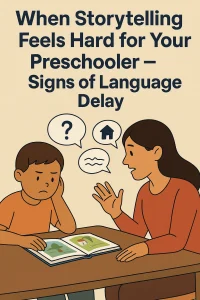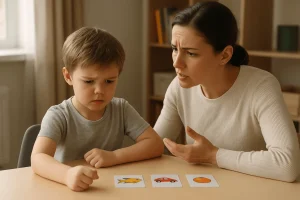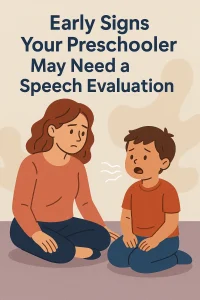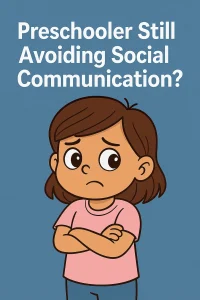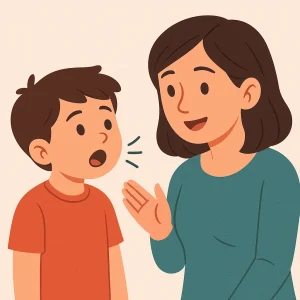Why Your 2-Year-Old May Not Be Following Simple Directions
Last Updated: August 5, 2025
“Can you give me the toy?”
You ask gently, but your 2-year-old stares blankly or walks away.
Sound familiar? Many parents start to worry when their 2 year old is not following directions, especially around the age of 2 when comprehension and communication skills are expected to grow rapidly. While some children are simply distracted or stubborn, for others, it could point to something deeper — like a speech delay in toddlers, receptive language issue, or even early signs of autism.
If you’ve found yourself Googling “Why is my toddler not listening?” or “Is it normal that my 2-year-old doesn’t follow directions?”, you’re in the right place. Let’s break it down — simply, clearly, and with expert-backed insights.
Free Speech Help for Kids
Concerned about speech delays? Book a free consultation with our expert speech therapist and get guidance tailored to your child’s needs.
Is It Normal for a 2-Year-Old to Not Follow Instructions?
If you’ve been calling your toddler’s name or asking them to “come here” or “pick that up,” but they seem to ignore you or look confused — you’re not alone. Many parents worry when their 2-year-old is not following directions, but in many cases, it’s a normal part of early development.
Developmental Milestones at 24 Months
By the age of 2, most toddlers are rapidly developing their language and comprehension skills. According to developmental guidelines:
- They should be able to follow simple one-step instructions, like “sit down” or “give me the ball.”
- They often understand between 200 to 500 words, even if they can’t say them all.
- They begin recognizing familiar routines and responding to common phrases used at home or daycare.
However, this growth isn’t the same for every child. Some toddlers may take longer to understand and respond, especially if they are more focused on exploring the world physically than communicating verbally.
Also read: A Guide to Speech and Language Milestones from Birth to 7 Years.
What “Following Simple Directions” Looks Like at Age 2
At this stage, “simple directions” typically mean:
- One-step verbal commands like “Come here,” “Give it to me,” or “Let’s go.”
- Responding when their name is called
- Following directions that include gestures or visual cues, such as pointing
A child who is developing typically might:
- Pause and look at you when you speak
- Attempt to follow the instruction (even if not perfectly)
- Show some understanding through actions, even without speaking
So, if your toddler doesn’t always comply, that’s okay — toddlers are known to test limits and assert independence. But if your 2-year-old is not understanding simple instructions at all, that might be worth observing more closely.
When to Be Concerned About a Toddler Not Listening
While occasional distraction or defiance is normal, consistent lack of response can be a red flag. You may want to seek professional advice if your toddler:
- Rarely follows simple one-step instructions without gestures
- Does not respond to their name consistently
- Seems confused by everyday commands that other children their age understand
- Has limited verbal communication or seems withdrawn
- Is not using any words or gestures meaningfully by 24 months
This could indicate challenges like receptive language delay, hearing issues, or even early signs of autism spectrum disorder. Early intervention makes a big difference, and recognizing signs early helps you take the next step confidently.
Remember: Not listening doesn’t always mean your child is ignoring you — it might mean they don’t fully understand the instructions or how to respond.
Common Reasons Toddlers Don’t Follow Directions
If your toddler seems to ignore you or looks confused when you give instructions, it’s easy to assume they’re being stubborn or defiant. But often, there’s more going on beneath the surface. Whether it’s a delay in understanding language, a hearing issue, or simply trouble paying attention, several common factors can affect how a toddler processes and responds to directions.
Let’s break down some of the most likely reasons — and how to spot them.
Receptive Language Delay
Receptive language delay occurs when a child has difficulty understanding spoken words and instructions, even if they appear to hear sounds normally. While expressive language relates to what a child can say, receptive language is about what they can comprehend.
This can have a big impact on everyday interactions. A toddler with receptive language delay may not seem to grasp even simple commands like “come here,” “sit down,” or “give me the toy.”
Signs your child may not be processing verbal instructions:
- They frequently ignore spoken requests or appear confused
- They rely on gestures or routines rather than verbal cues
- They don’t follow one-step instructions unless there’s a visual prompt
- They show signs of speech delay — limited vocabulary or unclear speech at age 2
If your toddler isn’t processing instructions as expected, it could point to a speech delay in a 2-year-old, especially if paired with limited word use or delayed comprehension. Early evaluation by a speech-language therapist can offer helpful insights and support.
Tip: Try pairing simple commands with gestures and routines to see if your toddler responds better. This can help bridge the gap while you seek support.
Hearing Issues or Sensory Challenges
Sometimes, when a toddler isn’t following directions, it’s not about language or behavior — it might be about how they hear or process sensory input.
Could it be a hearing issue?
Even mild hearing loss due to frequent ear infections or fluid in the ear can impact how clearly your toddler hears and understands instructions. A child may hear your voice but miss parts of words or sentences, making it difficult to act on what you’re saying.
Signs to watch:
- Not responding when called by name
- Turning the wrong way when you speak
- Needing visual cues to follow through
What about sensory processing?
Children with sensory processing issues may be easily overwhelmed by their environment. Loud noises, bright lights, or even clothing textures can distract or upset them, making it harder for them to focus on spoken commands. A toddler not responding to name consistently — especially in noisy or stimulating settings — might be showing signs of sensory challenges rather than just ignoring you.
A hearing test is a simple first step that can rule out a major cause of toddler communication issues. If hearing is normal, occupational therapy can assess for sensory difficulties.
Behavior or Attention Difficulties
Not all toddlers who ignore directions have a delay — sometimes, they’re just… being toddlers!
At this age, children are learning independence and testing boundaries. But for some kids, difficulty listening and focusing may be more than just “typical toddler behavior.”
Defiance vs. Developmental Delay
- A defiant child may understand your instruction but choose not to follow it (cue the smirk and giggle!).
- A child with an underlying attention issue may truly struggle to process and retain what you’ve said, especially if distracted.
Signs of attention-related concerns:
- Your child seems to jump from task to task without finishing
- They rarely make eye contact or seem engaged when you speak
- They only follow instructions in calm, quiet environments
It’s common for a toddler not to listen to commands now and then — especially when tired or overstimulated. But if your child is not listening but hears fine, and this happens often across different situations, it may be time to talk to your pediatrician or a developmental specialist.
Many parents mistake inattention or difficulty following instructions for disobedience. Observing patterns of behavior is key to understanding what’s really going on.
Could This Be an Early Sign of Autism?
It’s natural to wonder if your child’s behaviors might be more than just a developmental phase — especially when your 2-year-old isn’t responding to their name or seems disconnected during everyday interactions.
While there are many reasons a toddler might not follow directions or appear unresponsive, in some cases, these could be early signs of autism in toddlers.
How Autism Affects Language and Understanding
Autism Spectrum Disorder (ASD) is a developmental condition that affects how a child communicates, processes language, and interacts with others. It’s a spectrum, which means symptoms can vary widely — from mild social differences to more noticeable delays in speech and comprehension.
One of the most common early indicators of autism is difficulty with receptive language — the ability to understand spoken words. A toddler with autism might:
- Seem to tune out instructions or ignore spoken language
- Struggle with compliance, not because of defiance, but because the words don’t “click”
- Prefer repetitive actions or routines rather than engaging in back-and-forth play
This doesn’t mean every child who ignores directions has autism — but it’s worth understanding the signs so you can make informed decisions.
Autism Signs in a 2-Year-Old: What to Watch For
Every child develops at their own pace, but if your toddler shows multiple signs from the list below, consider talking with your pediatrician or a developmental specialist.
Common early signs of autism in toddlers include:
- Not responding to their name by 12–18 months
- Avoiding eye contact or appearing to “look through” people
- Not pointing to show interest (like pointing to a dog or airplane)
- Limited speech or using few words meaningfully
- Not imitating facial expressions, actions, or sounds
- Lack of interest in playing with other children
- Repetitive behaviors, like hand-flapping, spinning, or lining up toys
If you notice your 2-year-old isn’t pointing, doesn’t show interest in others, or doesn’t respond when called, these may be gentle red flags — not reasons to panic, but reasons to pay attention.
Note: Some toddlers are just quiet, independent, or take longer to engage. What matters most is observing patterns over time — and how your child interacts with others and the world around them.
Early Screening Makes a Big Difference
The good news? There are screening tools and expert evaluations available to help identify autism-related challenges early. The earlier you notice and act, the better the outcomes — because early support helps children build the skills they need for communication, learning, and connection.
If your instincts are telling you something isn’t quite right — trust them. And remember: getting a developmental check doesn’t mean labeling your child — it means supporting them.
Tools like an autism app for toddlers or online developmental screenings can guide you through early signs and help you prepare for your next steps.
When to Seek Help: Red Flags to Watch For
As parents, we’re often told not to compare our children to others — and while that’s great advice for most things, tracking developmental milestones is one area where comparison actually matters.
If your child is between 18 and 24 months and seems to be missing key milestones in speech, comprehension, or interaction, it may be time to take a closer look. Early support can make a big difference, especially when it comes to communication and social development.
Missed Milestones by 24 Months: What’s Typical vs. Concerning
By the time your toddler turns 2, most children are able to:
- Follow simple one-step directions like “give me the ball”
- Use around 50–100 words
- Combine two words together (e.g., “more juice” or “mama come”)
- Respond to their name consistently
- Point to familiar objects when named
- Show interest in playing or interacting with others
If your child isn’t doing many of these things, or is only doing them inconsistently, it could be a sign of a developmental delay in a toddler.
Keep in mind: missing one or two milestones might not be a serious concern — but a pattern of missed developmental markers by 24 months should be discussed with a pediatrician or child development specialist.
Language Comprehension Red Flags Checklist
Here’s a simple checklist of things to watch for. If your child shows multiple signs from this list, a speech-language evaluation may be helpful:
- Doesn’t respond to their name consistently
- Rarely follows simple directions like “sit down” or “come here”
- Doesn’t point to show interest or identify objects
- Doesn’t react to common phrases (“Let’s go,” “Time to eat”)
- Seems confused by familiar words or routines
- Limited verbal vocabulary (less than 20–30 words by 2 years)
- Relies mostly on gestures or grunts
- Doesn’t imitate words, sounds, or actions
- Lack of pretend play or social engagement with peers
These signs don’t necessarily mean your child has a serious condition — but they can signal a need for early intervention, which is known to improve speech and language outcomes significantly.
Early doesn’t mean “rushing.” It means being proactive and giving your child access to the tools they might need to thrive.
Who to Talk To If You’re Concerned
If you’ve checked off several of the signs above or have a gut feeling that something isn’t quite right, don’t hesitate to:
- Talk to your pediatrician about developmental screening
- Request a referral to a speech-language pathologist
- Explore trusted early intervention services in your area
- Consider using a speech therapy app or screening tool to begin observing patterns
What You Can Do at Home
If you’re concerned that your toddler isn’t following directions or responding consistently, the good news is — there’s a lot you can do right at home to help. With simple, playful strategies, you can strengthen your child’s listening and comprehension skills in everyday routines.
The key is consistency, patience, and fun. Let’s explore a few easy ways to support your child’s development using structured activities and playful learning.
Practice One-Step and Two-Step Directions
Learning to follow directions is a skill that develops over time — and like any skill, it improves with practice. A great starting point is working on one-step directions (“Give me the ball”) and gradually moving to two-step directions (“Pick up the toy and put it in the box”).
Simple Activities to Try:
- Toy Pickup Game: Ask your child to “pick up the red block” or “give me the car.” Keep it short and clear.
- Daily Routines: Use moments like getting dressed (“Get your socks”) or snack time (“Bring your spoon”) as chances to practice.
- Clean-Up Songs: Sing while giving instructions like “put the toys in the bin,” encouraging listening through rhythm.
Start with one-step requests and praise every successful response. Once your child masters these, gently introduce two-step directions, like “Go to your room and bring your shoes.”
Tip: If your toddler seems confused, break down your directions and pair them with hand gestures. This builds understanding and confidence.
Using these moments helps teach toddlers to follow directions in a way that feels natural and playful — not forced.
Engage with Speech Games and Flashcards
Kids learn best through play and repetition, and using visual tools like flashcards and games can make a big difference — especially for toddlers who struggle with verbal comprehension.
Try These Ideas at Home:
- First Words Flashcards: Use cards with pictures of everyday objects like animals, food, and toys. Say the word, point to the card, and ask your child to find or name it. Over time, mix in simple directions like “Touch the apple” or “Show me the dog.”
- Action Games: Play games like “Simon Says,” starting with easy commands: “Touch your nose” or “Clap your hands.” These games are fun speech games for toddlers that reinforce both listening and responding.
- Treasure Hunt: Hide toys and give clues like “Find the blue ball under the chair” — a great way to combine understanding with movement.
These visual and verbal pairing activities help your child connect spoken words with actions or objects. This is especially helpful if they’re still developing receptive language skills.
Bonus: These games also help build attention span, turn-taking, and memory — all crucial for communication!
Apps and Tools That Help with Speech and Following Instructions
In today’s digital age, support for speech and language development isn’t limited to therapy clinics or classrooms. If your toddler struggles with understanding directions or is showing signs of speech delay, there are now powerful tools available right at your fingertips — including apps specifically designed to boost communication skills in young children.
Whether you’re waiting for an evaluation or in-between sessions, a speech therapy app can support your child’s learning at home.
Best Speech Therapy App for Kids
Not all apps are created equal — but some are thoughtfully built with the guidance of speech-language pathologists (SLPs) and early childhood educators. The best speech app for toddlers are those that:
- Use clear visuals and simple prompts
- Encourage imitation and engagement
- Break down language concepts into fun, repeatable games
- Focus on core vocabulary, following instructions, and turn-taking
Many of these apps feature interactive speech games, matching activities, and visual cues — all of which are especially helpful for toddlers with delayed receptive language or those who are just starting to build verbal skills.
Look for features like real-child voiceovers, customizable levels, and rewards to keep your little one engaged while learning.
Why Use an Autism or Speech Delay App?
If your child is showing early signs of autism or isn’t meeting their language milestones, using an autism app for toddlers can help track behaviors, reinforce communication, and introduce structured routines.
These apps can:
- Teach basic concepts like “yes/no,” “more,” or “stop” through repetition
- Encourage gesture-based responses or visual schedules
- Reinforce following directions using visual and audio prompts
- Offer routines and predictable formats that children with autism often respond well to
A well-designed app for speech delay doesn’t replace therapy, but it can support and reinforce what’s being learned in professional sessions. It’s a great way for parents to stay involved in the learning process and make progress visible in small, rewarding steps.
Many apps also include progress tracking, so you can monitor your child’s responses over time and share insights with your therapist or pediatrician.
Teletherapy and Online Tools for Toddlers
If in-person therapy isn’t available — or if you prefer a more flexible approach — online speech therapy for toddlers is becoming an increasingly popular option. Platforms now offer:
- Real-time video sessions with certified speech-language pathologists
- Personalized plans based on your child’s needs
- Parent coaching and home activity suggestions
- Interactive exercises that mirror what happens in traditional therapy rooms
With online speech therapy, parents are empowered to become active participants in their child’s learning journey — and kids often feel more comfortable practicing in their own space.
Combine teletherapy with a supportive speech therapy app for daily reinforcement, especially when working on following instructions or building vocabulary.
Know more: Tele-BASICS – The Perfect Tool for Online Therapy
Professional Support: When to Contact a Therapist
As a parent, you know your child best. If something feels “off” — like your toddler isn’t understanding you, rarely follows directions, or isn’t hitting key language milestones — it’s okay to trust your instincts. While some children simply develop at their own pace, others may benefit from extra support. This is where a speech-language pathologist (SLP) can help.
When to Consult a Speech-Language Pathologist
You don’t need to wait until things feel “serious” to ask for help. In fact, reaching out early is one of the best things you can do for your child’s development.
Here are signs it might be time to schedule an evaluation:
- Your toddler is not speaking many words or using gestures meaningfully by age 2
- They struggle to follow basic instructions without visual cues
- You notice they are not responding to their name, pointing, or showing interest in interaction
- They’re frustrated when trying to communicate and often resort to tantrums
- You’re unsure if it’s speech delay, behavior, or something more
A licensed SLP can assess your child’s comprehension, vocabulary, and interaction skills — and give you clear guidance on what’s typical vs. what may need support.
Remember: You don’t need a diagnosis to start language therapy for toddlers. Support now can make future challenges much easier to manage.
How Early Intervention Makes a Difference
The toddler years are a critical window for language development. During this stage, the brain is highly responsive to new learning and stimulation. This is why early intervention works so well — the sooner you support communication, the better the outcomes.
Benefits of early speech therapy include:
- Building listening and comprehension skills
- Expanding vocabulary and sentence formation
- Strengthening social communication
- Reducing frustration and improving behavior
- Helping parents learn how to guide and support learning at home
Whether your child has a mild speech delay or more significant challenges, early support lays the foundation for future success in school, play, and relationships.
Where to Find Online Speech Therapy for Toddlers
Can’t find a local therapist? No problem. Thanks to technology, online speech therapy is more accessible than ever — and it’s just as effective for many families.
Benefits of online speech therapy for toddlers:
- Sessions happen in the comfort of your home
- Easier scheduling for busy parents
- Access to certified SLPs regardless of location
- Parent involvement and at-home speech therapy strategies built in
- Digital resources, games, and progress tracking
You can get started with a free consultation through many online therapy platforms. Some even offer apps and daily activity suggestions to reinforce learning between sessions.
Consider combining online speech therapy with at-home tools like flashcards, speech apps, and interactive games for a well-rounded approach.
Conclusion
Every toddler grows at their own pace, and that’s perfectly okay. If your 2-year-old isn’t following simple directions or seems behind in speech, don’t panic. Watch for patterns — not just one-time behavior. Some children take longer to understand and respond, and that’s normal. Still unsure? It’s always okay to ask for help. A speech therapist or online speech therapy for toddlers can give you clarity and support. Early help makes a big difference. You’re not alone — and you’re doing the right thing by looking out for your child. Keep going — your support truly matters.
Frequently Asked Questions:
1. Is it normal for a 2-year-old not to follow instructions?
Yes, some 2-year-olds may take longer to follow simple directions. But if your child never follows basic commands like “come here” or “give me the ball,” it could be a sign of a speech delay or language comprehension issue.
2. Why does my toddler ignore me when I give instructions?
Sometimes toddlers are distracted or tired. But if your child regularly ignores simple commands, it might be due to a receptive language delay, hearing problem, or early signs of autism.
3. What are the red flags for speech delay at 2 years old?
Some signs include:
- Not using 20–30 words
- Not following simple directions
- Not pointing or showing objects
- Not responding to their name
These may suggest a developmental delay in toddlers.
4. How can I teach my toddler to follow directions?
Use short, clear instructions like “sit down” or “bring the toy.” Add gestures and repeat often. Simple games and first words flashcards help make learning fun and easier to understand.
5. Should I be worried if my 2-year-old doesn’t respond to their name?
Yes, if your child often doesn’t respond when called, even in quiet settings, it could be a sign of hearing issues, sensory challenges, or early autism symptoms. Talk to your pediatrician.
6. What is receptive language delay in toddlers?
It means your child has trouble understanding words or instructions. Even if they can hear sounds, they may not process what the words mean. It’s a common reason why a 2-year-old might not follow directions.
7. Can speech therapy help my 2-year-old follow instructions better?
Yes! Speech-language therapy can improve your child’s listening, understanding, and speaking skills. A therapist uses fun activities and games to teach your toddler how to respond to commands and communicate clearly.
8. Are there apps to help with speech delay in toddlers?
Absolutely. You can try a speech therapy app or autism app for toddlers. These apps use games, sounds, and pictures to help kids learn new words and follow directions.
9. When should I contact a speech therapist for my toddler?
If your child is not using words, not following directions, or seems confused by simple commands by age 2, it’s a good idea to talk to a speech-language pathologist for an early evaluation.
10. Can online speech therapy work for toddlers?
Yes! Many families use online speech therapy for toddlers from home. It’s flexible, uses real therapists, and often includes activities you can do together to improve your child’s speech and comprehension.
About the Author:
Shravanaveena Gajula
M.Sc ., Speech and Language Pathology (5+ years of experience)
Shravanaveena Gajula is a dedicated Speech-Language Pathologist with a BASLP and an M.Sc in Speech and Language Pathology. With experience spanning multiple settings, including Wellness Hub , Veena specializes in a wide range of disorders from developmental issues in children to speech and language assessments in adults. Her expertise includes parent counseling, managing speech sound and fluency disorders, and creating individualized therapy programs. Veena is also PROMPT certified and an author of several insightful blogs on speech and language pathology, aiming to educate and assist caregivers in supporting their loved ones.
Book your Free Consultation Today
Parent/Caregiver Info:
Client’s Details:
* Error Message
